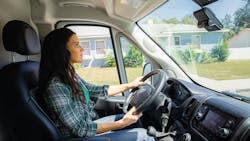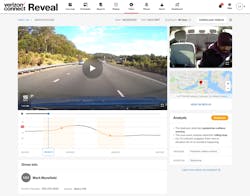Verizon Connect has expanded its AI-powered dashcam offering for fleet managers and drivers looking for more insights into dangerous events on the road. The new Verizon Connect Dashcam, released this month, uses artificial intelligence in real-time to detect hazardous driving and boost driver safety.
For new and existing Verizon Connect Fleet and Reveal customers, the Integrated Video option can be paired with two new camera models—a road-facing only camera and a dual-facing camera.
The company’s previous in-cab cameras, launched in 2019, relied on event triggers for the video to be uploaded, where Verizon Connect’s AI engine applied additional context, according to Lisa Donnelly, product leader at Verizon Connect.
See also: Excellent fleets know how to leverage data“What this new camera brings is the ability to detect a greater array of events that are visualized on the road—and you're actually able to detect when the driver is drowsy in real-time,” Donnelly told FleetOwner. “We’re uploading more information on event types over time, so it’s a more expansive array of events that we’re actually able to detect.”
The AI upgrade also provides in-cab coaching, Donnelly noted, so drivers are alerted at the moment of an unsafe action or condition. “Just having all of that additional information within both the Reveal and Fleet platforms really just empowers the fleet managers to just give some more context around what the drivers are doing on the road and where there may need to improve over time.”
What Verizon Connect's new dashcam does
The advanced driver assistance systems help monitor tailgating, pedestrians, and cyclists, while the driver-monitoring system tracks distracted driving, phone usage, fatigue, and more. The recently launched single and dual-camera model hardware features include:
- Upgradable from a single road-facing camera to dual camera functions with a driver-facing add-on.
- Single device for both road- and driver-facing footage, which Verizon Connect said is easy to self-install.
- The hardware is built to be upgradeable when new enhancements are created.
- The hardware comes with lens caps for privacy when video recordings are unwanted or not needed.
- Drivers will be alerted in-cab of unsafe driving events in real-time.
Verizon Connect’s AI dashcam alerts drivers when it detects unsafe driving, which includes signs of tiredness, distraction, and phone usage. It then tells drivers to take corrective action. Cloud-based AI distills data into insights and video footage is automatically analyzed for severity and tagged with context so that managers know what is essential and actionable to improve driver safety.
Customers can automatically send video footage of the incidents to the platform so that it can be reviewed by the appropriate people and managers. In the case of a driver recklessly driving, the manager can use the footage to coach and discuss safety habits.
According to the National Highway Traffic Safety Administration, driver assistance technologies can reduce traffic crashes and save thousands of lives.
Fleets of all sizes are buying into the safety and legal protections dashcams provide, according to Erin Cave, Verizon Connect’s director of product management. “What we’ve seen over the years is initially it was the larger fleets that made the investment in video and they wanted more,” she told FleetOwner. “Over the three years that we’ve had this out, it’s almost become like the telematics unit where eight to 10 years ago, people were slowly saying, ‘We should really monitor our drivers.’
“Some people were afraid of it or a bit nervous,” she continued. “But now everyone is seeing the value of it and the potential for the future. And micro fleets are using it as much as enterprise fleets.”
About the Author
Josh Fisher
Editor-in-Chief
Editor-in-Chief Josh Fisher has been with FleetOwner since 2017. He covers everything from modern fleet management to operational efficiency, artificial intelligence, autonomous trucking, alternative fuels and powertrains, regulations, and emerging transportation technology. Based in Maryland, he writes the Lane Shift Ahead column about the changing North American transportation landscape.


